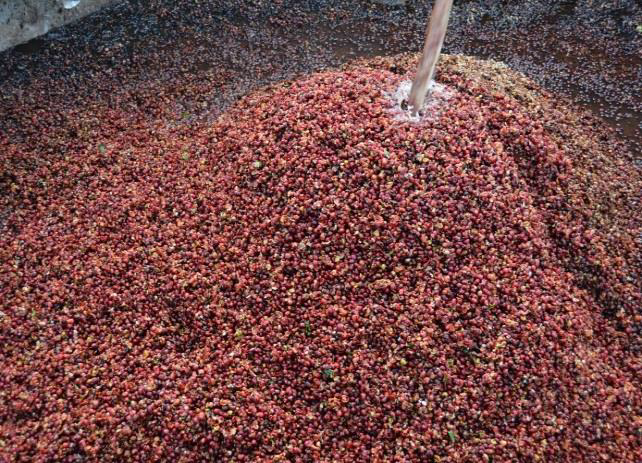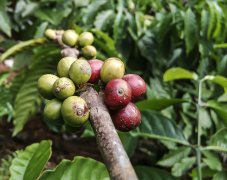Where can I find Kenyan coffee and raw beans in the sun? how about classic water washing and Kenyan flavor?
For professional baristas, please follow the coffee workshop (Wechat official account cafe_style)

Kenya Pearl Dou Top Sika producing area Honey Cooperative
(Kenya PB Top Thika Asali Cooperative)
Flavor description: grapefruit, mulberry, caramel, candied fruit-like sweet and sour feeling,
The flavor is full and juicy, crisp and sweet.
Producing area: Sika producing area (Thika)
Producer: honey Cooperative (The Asali Cooperative)
Variety: SL28 & SL34
Grade: PB Top
Altitude: average 1700 m
Treatment method: washing treatment method
The history of coffee cultivation in Kenya dates back to the end of the 19th world, and coffee trees were introduced from Ethiopia, a neighboring country to the north.
After the improvement of our own varieties, the common varieties are bourbon (Bourbon), Ken special (Kents,
SL34, SL28), Tibika (Typica) and Luli 11 (Riuri 11).
Now about 90% of the coffee varieties are SL34 and SL28. Batian, a new variety published in 2007, has not yet
Grow a lot. The vast majority of Kenyan coffee is grown organically without certification because of the use of improved planting techniques.
Chemical pesticides or herbicides are rarely used. All Kenyan high-end coffee is washed and sun-dried.
The low-grade products of non-washing treatment (non-washing 39% buni) are for local use only.
This batch of Sika honey cooperative AA Top is produced in the foothills of the Aberdare Mountains in Kenya.
There is a cooperative in the Great Rift Valley Sika region (Thika), which is connected to Ethiopia in the east.
Coffee produced by the Honey Cooperative (The Asali Cooperative), which is
The water treatment plant, made up of 155 small farmers from coffee families, has an annual output of 1200 bags of raw coffee beans.
Coffee comes from coffee beans planted by nearby coffee farmers, with an average of 250 beans per farmer.
Coffee trees, the harvested red fruits are handed over to the washing plant for treatment. The characteristics of the coffee here are
Black millet fruit flavor, flavor description: grapefruit, mulberry, caramel, candied fruit-like sweet and sour feeling,
The flavor is full and juicy, crisp and sweet.
No other country in the world attaches so much importance to the production of high-quality coffee as Kenya, so Kenya can be called the world.
The best model student in coffee-producing countries, because all Kenyan coffee must be handed over to the government after harvest.
The established Kenya Coffee Bureau (Coffee Board of Kenya, CBK) unifies the acquisition and cup testing and grading.
Every Tuesday, the officially established Nenobi Coffee Exchange (the Nairobi Coffee Exchange) in the capital
As a result of this open system under the overall management of the government, more than 570000 of Kenya has been encouraged.
It is not difficult for a small coffee farmer to get a good price as long as he has good quality. In fact, what the Kenyan government did
There is still a lot of support for the effort, and the government provides a large number of small coffee farmers with the skills to grow good coffee.
Coach nearly 300 agricultural transportation and marketing cooperatives (a bit like Taiwan agricultural production and marketing classes) for better handling of raw beans
Kenya Coffee Agency (CBK) provides production, quality research, sales and even financial guidance to the coffee industry.
Focus and educational counseling. It has created the unparalleled charm of the quality and flavor of Kenyan coffee.
Coffee buyers around the world love it, and Kenyan coffee is also very popular in Taiwan's coffee market.
Surrounded by Mount Kenya (MT. KENYA, volcano) and Elgang Mountain (MT. Elgon), the more famous producing areas
There are Meru, Thika, Nyeri, Nakuru, Embu and so on. The topography of Kenya is complex and changeable, including plateaus, deserts,
Canyons, grasslands, coffee-producing areas spread over the central and southwestern and eastern plateaus 1000 to 2500 meters above sea level
Regions such as Mount Kenya in the middle, Aberdare Zone in the Aberdar region, and Nyansa in the west
(Nyanza), Kasii (Kasii), Bungoma (Bangoma), eastern Kerry state (Kericho)
, Nakuru (Nakuru) The treatment of raw beans is mainly water washing, and the classification is based on particle size.
And its actual value is determined by cup test. The highest grade coffee beans are AA (large granulated beans left on the 7.2mm sieve)
, Grade A (the second largest granulated beans left on the 6.8mm sieve), B (the medium granulated beans left on the 6.2mm sieve),
Grade C (all small granulated beans less than B), PB (oval granulated beans), and too light and too small TT
And T-grade beans. Grade An and B beans are mixed and exported, called AB. Kenyan authorities (CBK) on coffee beans
People who love coffee because of their high requirements, consistent packaging, good quality and good texture.
Never forget to enjoy a cup of Kenyan coffee.
Important Notice :
前街咖啡 FrontStreet Coffee has moved to new addredd:
FrontStreet Coffee Address: 315,Donghua East Road,GuangZhou
Tel:020 38364473
- Prev

What is the level of detail of raw coffee beans in Kenya? what are AB round beans?
Professional barista exchange please follow the coffee workshop (Wechat official account cafe_style) Kenya Pearl beans Top Sika producing area Honey Cooperative (Kenya PB Top Thika Asali Cooperative) flavor description: grapefruit, mulberry, caramel, candied-like sweet and sour taste, full and juicy, crisp and sweet. Production area: Sika production area (Thika) producer: honey cooperation
- Next

Introduction of the highest grade AA washing treatment method in the coffee and honey cooperative of Kenya in the latest production season of 2018
For the exchange of professional baristas, please follow the coffee workshop (Wechat official account cafe_style) Kenya Sika producing area Honey Cooperative AA Top (Kenya AA Top Thika Asali Mugaga Cooperative) producing area: Sika producing area (Thika) producer: honey Cooperative (The Asali Mugaga Cooperative) varieties: SL28 SL34 Grade: AA Top Sea
Related
- Detailed explanation of Jadeite planting Land in Panamanian Jadeite Manor introduction to the grading system of Jadeite competitive bidding, Red bid, Green bid and Rose Summer
- Story of Coffee planting in Brenka region of Costa Rica Stonehenge Manor anaerobic heavy honey treatment of flavor mouth
- What's on the barrel of Blue Mountain Coffee beans?
- Can American coffee also pull flowers? How to use hot American style to pull out a good-looking pattern?
- Can you make a cold extract with coffee beans? What is the right proportion for cold-extracted coffee formula?
- Indonesian PWN Gold Mandrine Coffee Origin Features Flavor How to Chong? Mandolin coffee is American.
- A brief introduction to the flavor characteristics of Brazilian yellow bourbon coffee beans
- What is the effect of different water quality on the flavor of cold-extracted coffee? What kind of water is best for brewing coffee?
- Why do you think of Rose Summer whenever you mention Panamanian coffee?
- Introduction to the characteristics of authentic blue mountain coffee bean producing areas? What is the CIB Coffee Authority in Jamaica?

